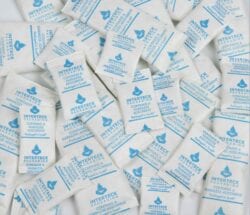The debate between using an oxygen absorber or desiccant vs silica gel has been a constant, especially in the food industry. With more food being packaged for later consumption, the argument on which of the two is a better preservation alternative has only escalated.
However, the difference between the two remains a mystery to the general public. More so due to the use of these little sachets in things other than food. So, here is a closer look into the differences between silica gel packs and oxygen absorbers.
Silica gel packs
Silica gel is mainly composed of porous sand or silicon dioxide. It minimizes condensation and keeps stored objects dry even in highly moist and humid environments. Silica gel is most commonly found in the packaging of bags, supplements, footwear, and computer equipment, among other things.
These moisture absorbing packets provide a distinct advantage in preventing mold formation inside the packaging. Therefore, manufacturers may also use them to store food such as seafood, meats, fish, poultry, fruits and vegetables, linen, and blankets.
Advantages of using silica gel packs
Silica gel packets can be handy for storing more than just food. They are the most commonly found desiccants in most packaging for new products. Here are a few reasons why.
- Silica gel is non-flammable, non-toxic, and chemically non-reactive.
- It is frequently used in dry food packing as a food moisture absorber to prevent deterioration of food quality.
- Silica gel can be reused by heating it to eliminate the previous absorption.
- The desiccant may also be used for traditional packaging and comes in a variety of sizes to suit various purposes.
- Silica gel absorbs around 40% of its weight in humidity or oxygen.
- When properly maintained, silica gel has an indefinite shelf life.
- Silica gel packets can also assist in eliminating odors.
Also Read: A Brighter Future Awaits For Pharma Franchise Industry in India
Disadvantages of using silica gel packets
Now silica gel is largely completely safe when packed. However, it can pose certain disadvantages when opened or if the silica gel itself comes in contact with the contents of the packaging.
- Although silica gel is completely non-toxic, it can pose a choking hazard for children if swallowed accidentally.
- Inhalation of silica gel may irritate the lungs.
- When the dust from silica gel beads comes into contact with the skin or eyes, it can cause irritation and redness.
Oxygen absorbers
Oxygen absorbers, or oxygen scavengers and desiccants, are little pouches filled with iron fillings, salt, and clay. The clay generates moisture, and the addition of salt causes the iron filings to absorb any oxygen.
When it is exposed, the oxygen absorption process begins. The iron contents immediately begin to oxidize, forming rust and subsequently releasing nitrogen. This nitrogen keeps food fresh for a longer period. The absence of oxygen in the container also helps keep insects away from the food item.
These oxygen absorber packs also contain little blue pills that turn color to pink when it is no longer effective.
Advantages of using oxygen absorbers
In comparison to silica gel packs, oxygen absorbers can have a larger number of advantages. The food manufacturing and production industry especially rely on them to maintain color, freshness, flavor, and vitamin and fat content. Some of the reasons for the same have been discussed below.
- By absorbing the majority of the oxygen in the package, oxygen absorbers successfully decrease the aerobic environment to 0.01 percent oxygen.
- Oxygen absorbers are non-toxic, non-hazardous, and safe to use in food preservation. It is recommended that food manufacturers only use oxygen absorbers in food packaging to avoid color change and infection.
- They keep oils from becoming rancid and aid in keeping bacteria and fungus at bay.
Disadvantages of using oxygen absorbers
Oxygen absorbers are extremely useful in maintaining food quality. However, they, too, have adverse effects from time to time. Some of their adverse effects have been listed below.
- Manufacturers can only use them to pack dry foods and foods with minimal oil content.
- Oxygen absorbers are only useful for materials containing less than 10% moisture. Otherwise, it poses a risk of botulism poisoning.
- Only minimal amounts of oxygen can be removed from each package with oxygen absorbers.
- They are single-use only and not reusable.
Parting thoughts
Now that we’ve taken a deeper dive to understand the difference between the two products, the debate of oxygen absorbers vs silica gel is only half settled. In fact, it may have just escalated further, given the wildly helpful nature of both.
Nevertheless, try opting for Interteck silica gel packets and oxygen absorbers since food packaging is a sensitive undertaking. There can be no compromise in food safety, given that food directly affects the human body.


